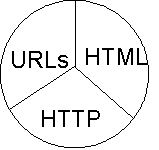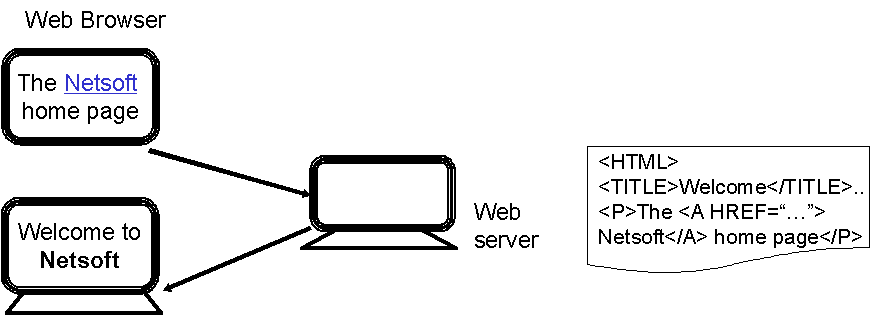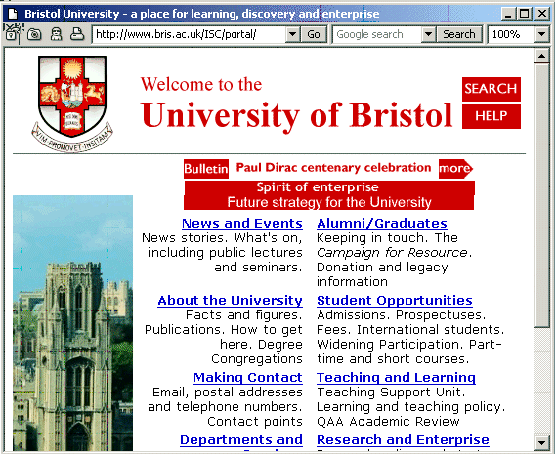Universal Web Acessibility:
Is It Possible?
| Brian Kelly | Jenny Craven |
| UK Web Focus | Research Associate |
| UKOLN | CERLIM |
| B.Kelly@ukoln.ac.uk | j.craven@mmu.ac.uk |
Contents
- Introduction To The Speakers
- Brian Kelly, UKOLN
- Jenny Craven, CERLIM
- Universal Access For All:
- The Web Architecture
- The People Factor
- Implementation Challenges:
- Current State Of UK HEI Web Sites
- Accessibility and Usability
- Conclusions
The Speakers
Brian Kelly:
- UK Web Focus
- JISC-funded advisory post
- Based at UKOLN, University of Bath
Jenny Craven:
- Research Associate
- Based at CERLIM, Manchester Metropolitan University
The Web Vision
The Web was developed in order to provide universal access to
digital resources, and independency from:
- Platforms
- Applications
- File formats
through use of open standards
Standards
Before the Web:
- Access to resources typically required use of software vendor's software
- Often this was only available on limited no. of platforms
- Often the software would be licensed
The goal of the Web was to provide universal access to resources.
Who could argue with this goal?
Need for standards to provide:
- Platform and application independence
- Avoidance of patented technologies
- Flexibility and architectural integrity
- Long-term access to data
The Case For W3C Standards
Why use open standards developed by the W3C? Why not leave it to the marketplace?
- W3C's open standards have been developed in an open environment,
with the aim of achieving platform and application independency
- Commercial companies develop proprietary formats in order to
maximise their profits and dividends to shareholders
- W3C's open standards have been developed to interoperate with
each other according to W3C's design vision
- Commercial companies typically develop proprietary formats in isolation,
or along the lines of a company vision
The Web Architecture
 The Web was developed based on three key architectural foundations:
The Web was developed based on three key architectural foundations:
- Data format (HTML)
- Transport (HTTP)
- Addressing (URIs)

HTML Is Dead!
Emphasis on managing HTML resources inappropriate:
- HTML is an output format, which cannot easily
be reused (e.g. WAP, e-Books, etc.)
- Need to manage HTML fragments (only partly achievable with SSIs)
- Need to manage collections of resources
- Need to have single master source of data
- Need to support new developments such as personalisation
- Difficult to integrate with new formats
Issues:
- Should we stop giving HTML training courses?
- Should we stop buying HTML authoring tools?
XML - The Key Meta Format
XML:
- Extensible Markup Language
- A lightweight SGML designed for network use
- A language for describing other languages
- Addresses HTML's lack of evolvability
- Arbitrary elements can be defined (<STUDENT-NUMBER>>, <PART-NO>, etc)
- Agreement achieved quickly - XML 1.0 became W3C Recommendation in Feb 1998
- Support from industry (SGML vendors, Microsoft, etc.)
- Need for accessibility support in from start
....
XML Concepts (1)
Well-formed XML resources:
- Make end-tags explicit:
- Make empty elements explicit: <img ... />
- Quote attributes <img src="logo.gif" height="20"
- Use consistent upper/lower case <p> and
<P> are different
XML Namespaces:
- Mechanism for ensuring unique XML elements e.g. a library application
containing the TITLE of the XML page, the TITLE of a book and the TITLE of:
<?xml:namespace ns="http://loc.org/.1998-001" prefix="i">
<p>Book: <i:TITLE>The Bible</i:TITLE>/p>
<p>Borrower: <j:TITLE>Mr</j:TITLE>
XML Concepts (2)
XML Schemas:
- Allow constraints to be applied on XML attributes
- Express shared vocabularies and allow machines to carry out rules made by people
- Richer than DTDs
- See <http://www.w3.org/XML/Schema>
XSLT:
- A language for transforming XML from one XML application to another or to another format (e.g. PDF)
- Written in XML
- Knows about XML (e.g. tree structures, etc.)
- See <http://www.xslt.com/>
XML Concepts (3)
XLink sophisticated hyperlinking:
- Links that allow you to choose multiple destinations
- Bidirectional links
- Links with special behaviours:
- Expand-in-place / Replace / Create new window
- Link on load / Link on user action
- Link databases
- See <http://www.xml.com/pub/a/2000/09/xlink/>
XPointer/XPath:
- Provides access to arbitrary portions of XML resource
- See <http://www.w3.org/TR/xptr/>
Getting To XML With XHTML
XHTML:
- HTML represented in XML
- Some small changes to HTML:
- Elements in lowercase <p> not <P>
- Attributes must be quoted <img src="logo" height="50">
- Elements must be closed:
<p >... </ p>)
<img src="logo" ... />
- Gain benefits from XML
- Tools available (e.g. HTML-Kit from <http://www.chami.com/html-kit/>)
- See <http://www.webreference.com/xml/.column6/>,
<http://groups.yahoo.com/.group/XHTML-L/> and <http://www.ariadne.ac.uk/.issue27/web-focus/>
CSS - Where You Define The Appearance
HTML/XHTML should be used to describe the basis document structure
CSS (Cascading Style Sheets):
- Should be used to describe how documents should be used to
describe how the document will be displayed
- Separation of structure from appearance helps management
(cf. modular programming)
- Designed with accessibility in mind
W3C Standards - Conclusions
W3C are coordinating the development of new open standards which:
- Address the limitations of the original Web architecture
- Are designed to provide device and application independence
- Have accessibility considerations built-in from scratch
- XHTML and CSS are the ideal now
Let us now move away from standards and consider the people aspect
JC's slides next
What Is Accessibility?
Ensuring systems and interfaces can be read by all users through:
- Access to hardware and software
- Use of appropriate assistive technology and accessibility features
- Ensuring information can be interpreted by the technology i.e. design for all
Why Make Information Accessible?
- Resources provided online
- Growth of online learning, online tutorials, etc.
- Inclusive society - widening access, information for all
- Legislation e.g. Disability Discrimination Act, 1995; SENDA, 2001
What Are The Benefits Of Universal Access?
It helps people with:
- Visual impairments
- Learning disabilities
- Mobility impairments
- Hearing impairments
- Speech impairments
- Seizure disorders
(source: Burgstahler: Universal design of distance learning)
What Are The Benefits Of Universal Access? (2)
It also helps people who are:
- Using a PC with graphics switched off
- Working in a noisy environment
- Using a PC with a slow connection
- Using other Web-based devices e.g. phones, PDAs, ...
Accessible Web Design
- Text descriptions for all images and sound
- Contrasting colours
- Plain fonts with adjustable font sizes
- Properly labelled frames and tables
- Alternatives for scripts, applets, plug-ins, etc.
Checking for Accessibility
- WAI Guidelines and Quick Tips Checklist
- Automated tools
- Validation services
- Web Audits and Policies
- PEOPLE!!!!!
So Why Are People Important?
- A Web site can comply with open standards
- A Web site can pass all the automated accessibility checks
- A Web site can appear to be accessible, BUT
- An accessible Web site is not necessarily usable
- The best way to test for usability is by involving PEOPLE, i.e. the users
Usability Issues
- Appropriate alternative text for images, links etc.
- Use of unambiguous language
- Clear and consistent layout and labelling
- Logical navigation of forms, search screens etc.
- Interactive elements: online chat, quizzes, new windows, pop-up windows, etc.
Checking For Usability
- Automated checkers e.g. LynxView, Bobby, etc.
- Ensure features can be altered e.g. font size, colours, etc.
- Try pages with graphics turned off, different colours, etc.
- Try pages using a number of Web browsers
Checking for Usability
- Sample size - Don't panic!!!
Ideally, try to use a sample of:
- People with mixed abilities i.e. experienced, novice, visual impairment,
hearing impairment, etc.
- People using different assistive technologies
Checking for Usability
- Observation
- Transaction logging
- Verbal protocol
- Questionnaires and/or interviews
Implementation Challenges
We have:
- Given an overview of the original Web framework and basic
design principles
- Outlined the importance of a people-oriented approach to complement
the technical architecture
- Outlined basic design principles for usable and accessible Web services
This sounds great in theory, but what around real-world deployment issues:
- An accessibility & usability case study
- Challenges at the institutional level
Case study: The NoVA Project
NoVA: Non-visual access to the digital library:
- To develop understanding of the information seeking behaviour
of blind and visually impaired people in web-based digital library resources
NoVA Usability Testing
- Sample of 20 'sighted', 20 'visually impaired' users
- Semi-structured tasks using four electronic resources
- Map search process together with verbal dialog
- Pre- and Post-task questions
Examples Of Observations
- Surveying page
- Time taken
- Types of mouse clicks and keystrokes
- Problems experienced
- Tackling problems
- Successful interaction
- Performance of assistive technologies
Examples Of Usability Questions
- Navigation
- Searching
- Browsing
- Results
- Getting lost
- Other resources
Conclusions Derived From NoVA Usability Testing
- Usability issues
- Design issues
- Training issues
- Software issues
BK's slides next
Implementation Challenges
In the real world Web we need to recognise several implementation challenges:
- Deficiencies in specs, tools, etc.
- Migration and support implications
- Addressing user needs and resourcing implications and not just
technical considerations
The Real World Web
In the real world Web we need to recognise several external factors:
- Due to the rapid development of Web specs ("the Web year")
the specs themselves may be flawed, ambiguous or over-ambitious
- Software has bugs (the cockup theory)
- Software vendors have their own agendas (conspiracy theory)
Together with local factors:
- Inertia / unwillingness to act as guinea pigs
- Licensing costs
- Support issues
- ...
UK HEIs - A Case Study
In Sept 2003 a survey of accessibility of 160+ UK HEI entry points was carried out:
- Used Bobby tool
- Only reported on problems which could be spotted using an automated tool
- How many WAI AA compliant entry points do you think were found?
Accessibility Survey Of UK HEI Entry Points
The Sept 2003 survey of accessibility of UK HEI entry points found:
The UK HEI Web management community is aware of importance of accessibility
and wants to implement accessibility. What are the difficulties?
UK HEIs - A Case Study (2)
An example of a AA-approved site is the
University of Bristol -
use Bobby to check if it is still accessible.

-

UK HEIs - A Case Study (3)
Typical problems found:
- Missing DOCTYPES
- Use relative sizing and positioning (% values) rather than absolute (pixels)
- Missing <kbd>ALT</kbd> attributes in <kbd>IMG</kbd> tags
The first two problems could be fixed with little effort on a single page
The third problem may conflict with usability criteria
Let us now:
- Look at the challenges in accessible Web sites (and not just pages)
- Consider the usability issues
WAI Implementation Challenges (1)
Many University Web managers want to comply with WAI guidelines
but have encountered implementation challenges:
- Limitations of authoring tools
- Browser bugs (e.g. Netscape 4)
- Apparent conflicts over usability and accesibility
- Resource implications of deploying new tools, training, etc.
- The scope of large institutional Web sites
- Finding the funding
WAI Implementation Challenges (2)
One Web manager commented "I too have recently been struggling
with just how rigorously the WAI guidelines should be implemented.
I certainly aspire to comply as fully as I can with the WAI guidelines but ..."
- Some guidelines are too theoretical
-
- Will have a pragmatic approach:
- Use tables for positioning
- Will not associate form controls for search boxes
- Not necessarily nest headers correctly
Accessibility Policies
You may wish to have an institutional accessibility policy:
All resources on the University Web site will comply with WAI AA
But:
- Is this practical
- All Web sites?
- What about MS Word / PowerPoint documents?
- How will compliance policed / measured?
- What about difficult areas (e.g. 3D maps)?
- What about people? What about usability?
- How will this be funded?
- Is this policy intended to be rigorously enforced, or does
it define an aspiration?
Conclusions
Standards:
- Use of open standards promises to provide a rich and
platform- and application-independent framework which the HE sector needs
- However deployment of standards-based services in a real-world context is not necessarily easy
Accessibility:
- Technical aspects are an essential but not sufficient condition
- Ensure that user issues are addressed
- You should address usability issues alongside accessibility
- There is probably a need for an accessibility institutional
policy - but thought will be needed for this
Advice and Good Practice:
 The Web was developed based on three key architectural foundations:
The Web was developed based on three key architectural foundations:
 The Web was developed based on three key architectural foundations:
The Web was developed based on three key architectural foundations:
 -
- 